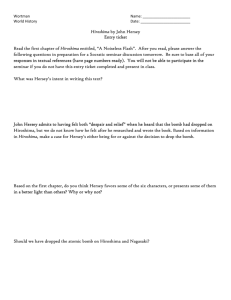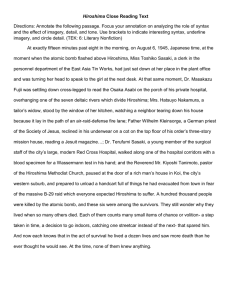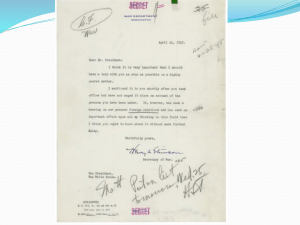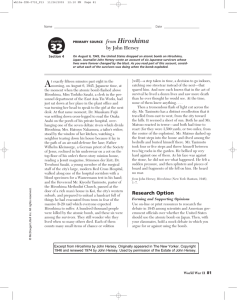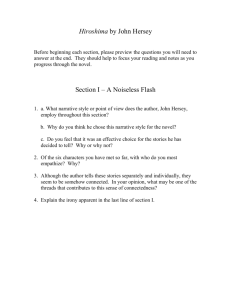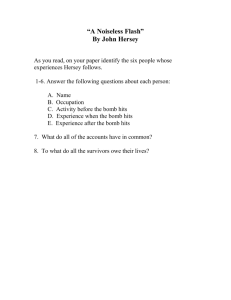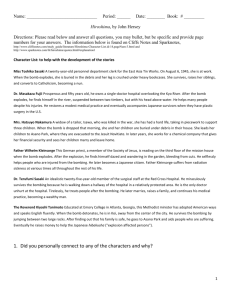STS.464 Technology and the Literary Imagination
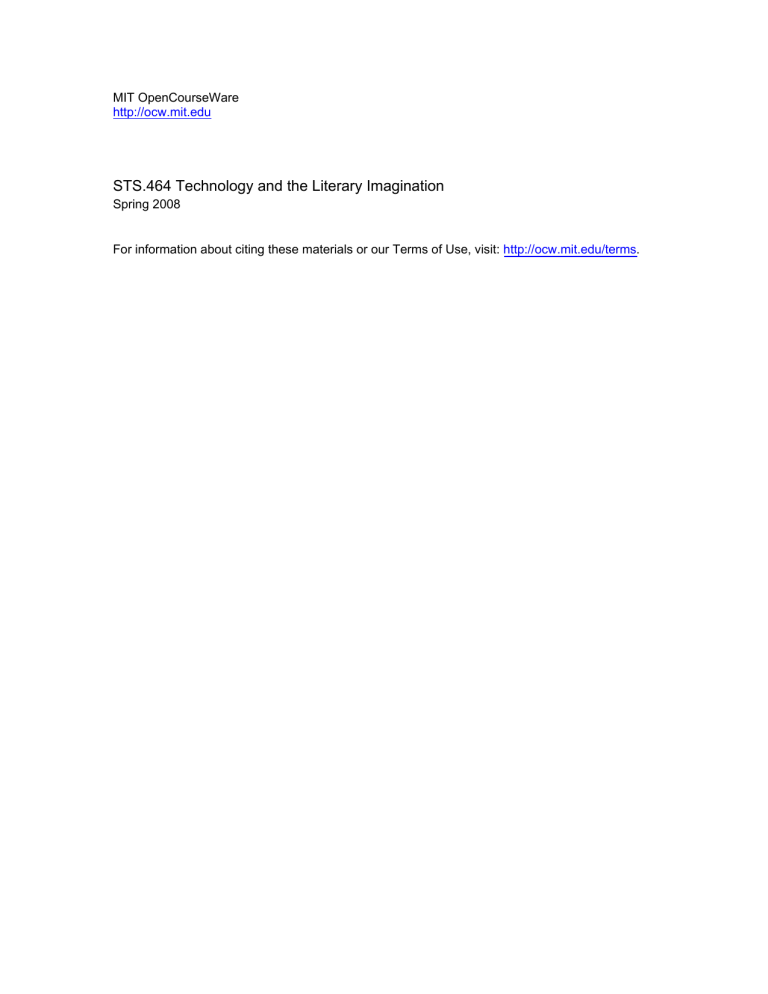
MIT OpenCourseWare http://ocw.mit.edu
STS.464 Technology and the Literary Imagination
Spring 2008
For information about citing these materials or our Terms of Use, visit: http://ocw.mit.edu/terms .
Ecological Crisis I: John Hersey’s Hiroshima
An unknown force
STS 464 – Technology and the Literary Imagination SPR 08
Daniel Cardoso Ll.
*
The dazzled surviving population of Hiroshima, during the immediate days after the Enola Gay launched the first atomic bomb, was –if we are to give Hersey’s journalistic piece full credit- making efforts to make sense of the indescribable amount of destruction that was delivered to them, through different ad-hoc explanations. These explanations, drawn by characters or merely described by them from accounts of the people around them, called my attention because of their ingenuity and strange beauty, and as evidence of their powerlessness against an unknown force. Hersey succeeds in conveying the impotence, both of action and of understanding, that followed the noiseless flash of the atomic bomb on August 6, 1945.
A cluster of bombs, (poetically called “flower basket case” in Japanese), a cloud of explosive gas, an improbable plane (a “Mr. B.” perhaps) spraying gasoline over the city and then setting it on fire, a mysterious magnesium powder that exploded when in contact with the power lines of the city, and finally to the no less mysterious and unexplainable
“atom-bomb” that used “the power released when an atom is somewhat split in two”
(p.62). As minutes, hours and days pass, these hypotheses are cyclically put forward and dismissed as they fail to account for the magnitude of the event. In all cases, are attempts to account fot something that escapes their understanding. It would be inappropriate to
describe this as a micro cargo-cult of atomic destruction, yet the events did render a modern city to a stage of primitive amazement in the face of –importantly- artificial phenomena.
“The hell she [Hatsuyo Nakamura] had witnessed and the terrible aftermath unfolding around her reached so far beyond human understanding that it was impossible to think of them as the work of resentable human beings, such as the pilot of the Enola Gay and President Truman, or the scientists who had made the bomb- or even, nearer at hand, the Japanese militarists who helped bring on the war. The bomb seemed almost like a natural disaster(…)”
(p.93)
More than half a century after the bomb the ethical implications for science –and politics- of the atomic (and scientific) enterprise remain problematic.
The perspective of the victims so vividly described by Hersey emphasizes the contradictions and dangers of the “expansionary ethos” (Marx, p.9) of the capitalist world in a way that a scientific account of environmental destruction could not. The strange, collective lapsus of
Hiroshima’s people (no one heard the explosion) is intriguing and difficult to capture through statistics.
“Almost no one in Hiroshima recalls hearing any noise of the bomb. But a fisherman in his sampan on the Inland Sea near Tsuzu (…) saw the flash and heard a tremendous explosion; he was nearly twenty miles from Hiroshima,
1
In On American Institutions and Ecological Ideas , Leo Marx suggests that the fact that scientists deal with very specialized fields of knowledge prevents them from seeing the bigger picture of environmental depredation (and therefore human selfdestruction) that the scientific world seems to inadvertently serve. Does this sort of distributed blindness account in some ways for the notion of technological determinism?
Or is there indeed a discernable human agency (either collective or individual) behind the
“progress” of science. Is Daniel Dennet’s idea of a free-floating rationale , a logic that is not attributable to a specific agent, or group of agents, but to the emergent properties of a large –economic, biological, ideological- system a possible answer to this question?
but the thunder was greater than when the B-29s hit Iwakuni, only five miles away.” (p.6)
What can we make of this collective lapsus of the senses? The fact that the bomb was not heard in Hiroshima speaks of a total obliteration of perception and understanding, for it seems clear that the sound must have been unbearably loud, perhaps to the point of annihilating the perception of sound itself. None of the hibakusha are, however, deaf in Hersey’s account. Is this a poetic license from the author?
**
It is hard not to see some irony in Hersey’s description of an old Tanimoto, who in the aftermath of the war became a sort of free-lance prohibakusha fund-raiser; his intervention before the United States senate, in which he thanks the United States for its generosity, and for “enabling [Japan] to rise from the ashes of ruin and reborn”, is particularly difficult to parse; is Tanimoto’s speech a servile act of self-promotion or a honest statement of gratitude towards the nation that was welcoming him as a witness and as a symbol of its destructive power; how can this be understood without having a deep knowledge of the Japanese character? Hersey –and here lies part of the journalistic power of his work- refrains from making any explicit judgments; yet ends the book with eloquent descriptions of the late Fujii, eagerly embracing alcohol, baseball, English, massages, golf (before dying), and the late Tanimoto, comfortable and numb in his postwar Japanese version of the American way of life, a way of life deeply entrenched with technology.
“He [Tanimoto] lived in a small little house with a radio and two television sets, a washing machine, an electric oven, and a refrigerator, and he had a compact Mazda automobile, manufactured in Hiroshima. He ate too much. He got up at six every morning and took an hour’s walk with his small woolly dog, Chiko. He was slowing down a bit. His memory, like the world’s, was getting spotty.” (p.152)
